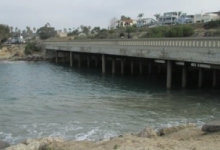
Posted on June 11, 2015
Earthmovers will be at the
This annual inlet excavation reconnects San Elijo Lagoon to the Pacific Ocean. The San Elijo Lagoon Conservancy oversees the process.
“The lagoon’s inlet and channel appears open but is approximately 80 percent blocked,” said Doug Gibson, Conservancy executive director and principal scientist.
“Tidal circulation is significantly muted as a result of sand buildup under the coast highway bridge and in the main channel.”
The small opening, just south of San Elijo State Beach Campground, is the lagoon’s only access to the Pacific Ocean. Left unattended, it could remain closed much of the year from buildup of sand by high incoming tides and surf. The cooler winter and spring weather help keep oxygen levels in the lagoon in the safe zone, but as temperatures rise in late spring and the demand for oxygen increases, an inlet operation is conducted. The inlet excavation is scheduled so as not to interfere with grunion spawning.
Dredging is like watching giant beach toys sculpt the lagoon’s opening. The excavation costs approximately $100,000 and is done through the support of California Coastal Conservancy and County of San Diego Department of
It has been decades since San Elijo Lagoon was naturally connected to the Pacific Ocean. The first bridge and berm crossing the lagoon was built in 1887 for the
Several fish populations, including halibut, depend on the lagoon as a nursery. Stagnant water also can trigger a rise in mosquito populations, which is why the county covers part of the project’s costs.





